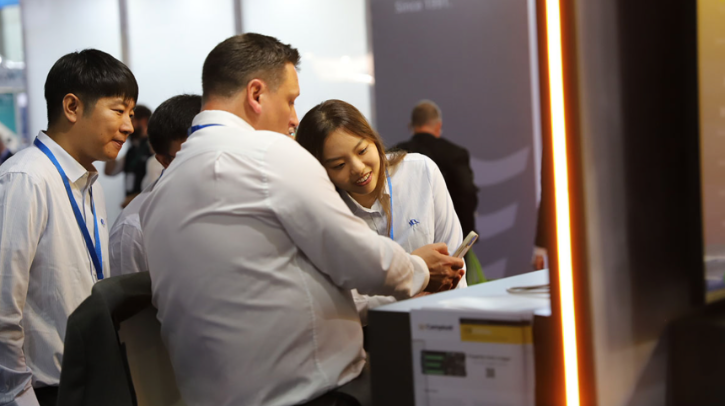Jean Bienvenu Dinga, director of Congo’s National Hydrological Service and Congo’s WMO representative, said, “I’m happy to be here with the WMO. It’s so important to come to this show and find solutions with the operational ability to adapt to the impacts of climate change.”
Jane Warne, chair of the Standing Committee on Measurements, Instrumentation and Traceability (SC-MINT) and principal meteorologist at the Australian Bureau of Meteorology, commented, “For me, this is a very important activity. Connecting the industry and the user gets better outcomes all around. There’s a lot of learning going on – even for someone like me, who’s been in this space for a long time.”
Meteorological Technology World Expo, the world’s leading meteorological exhibition, welcomed more than 150 international exhibitors from all over the world last week to the Messe Wien Exhibition & Congress Center in Vienna, Austria.
With the latest meteorological, hydromet, metocean and environmental monitoring technologies and services on show, attendees were able to take advantage of three full days of intense networking with a wide range of industry experts. Many products were launched and executive partnerships were forged with visiting buyers from national meteorological and hydrological services, environmental agencies, research institutes, universities and a whole host of weather-critical industries, including aviation, road, rail, maritime, retail, renewable energy, offshore, insurance, leisure, utilities and more. 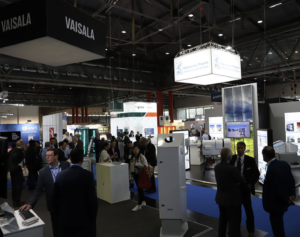
Project launches
For example, Vaisala announced the installation of the European OPERA radar network’s first C-band solid-state power amplifier (SSPA) weather radar for professional use by the Estonian Environment Agency in Tallinn. According to the partners, this first-of-its-kind implementation modernizes the European observation network with improved performance, reliability and cost-efficiency over traditional tube technology radars. The first phase of the installation will be completed by October 2024, with a second C-band SSPA radar to be installed next.
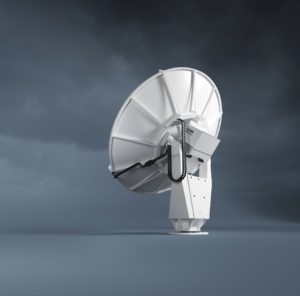
AEM debuted its Multi-Source Hazard Detection technology. Now integrated within the AEM Elements 360 application, Multi-Source Hazard Detection enhances the identification of and response to diverse environmental threats. By leveraging data from multiple sources, the technology delivers unmatched speed, accuracy and confidence in detecting potential hazards across geographically linked areas.
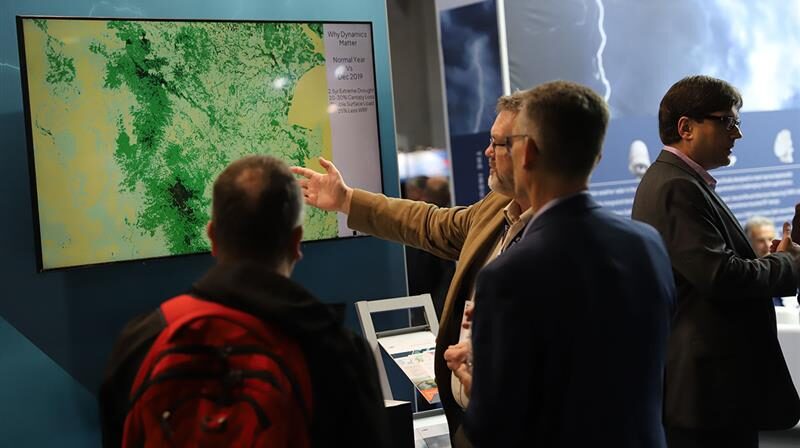
Geolux launched its datalogger for environmental monitoring at the show. The new SmartObserverPlus datalogger integrates with various instruments and sensors, offering multiple communication interfaces, including RS-232, RS-485 Modbus, SDI-12, CAN and ethernet. It features an integrated MPPT battery charger for efficient power management, ensuring reliable operation even in remote locations. The datalogger comes in single or dual SIM versions for reliable communication. Configuring the datalogger is straightforward using an intuitive PC application, and advanced users can take advantage of an embedded MicroPython engine to write custom scripts and take full control of the datalogger.
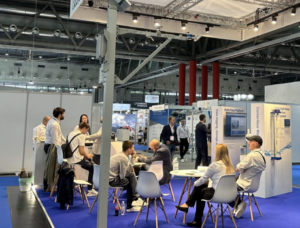
Campbell Scientific also launched its new, cloud-based software service, CampbellCloud, at the expo. The solution is built using modern cloud architecture, making it secure and resilient. When designing CampbellCloud, the company listened to its users and focused on the core features clients want, delivering these within a modern UI that’s simple to navigate and instantly becomes familiar as you navigate between applications.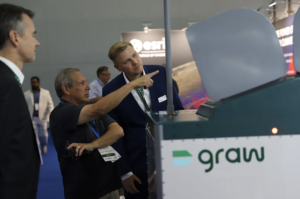
Alongside these announcements, Graw Radiosondes gave visitors a preview of its lidarCube proof of concept ahead of commercial production. This commercial lidar system offers high-precision 3D wind and temperature profiles up to 100km. The ground-based system can perform real-time measurements of temperature, wind direction, wind speed, humidity, density and some aerosols. It is projected to be released at the end of 2024, after the company has finished testing its ability to measure and receive data. Graw says the system’s compact, robust design makes it the ideal solution for large synoptic networks and for optimizing atmospheric measurements in research, space and defense.
Technical Conference on Meteorological and Environmental Instruments and Methods of Observation (TECO-2024)
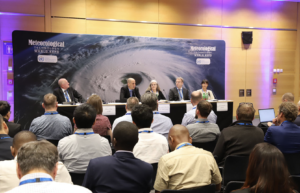
Meteorological Technology World Expo also hosted the WMO Technical Conference on Meteorological and Environmental Instruments and Methods of Observation (TECO-2024) – one of the most important events in the meteorological industry calendar. The event’s theme was on ‘Measurements and new technologies for WMO priority initiatives’. A total of 56 oral presentations and 175 poster presentations were delivered by experts.
Among the top presenters were: Dr Yubao Chen, director of radar operations and control office at the Meteorological Observation Centre, China Meteorological Administration; Beatrice Vincendon, head of surface observing network department of the observing systems direction at Météo-France; Dr Carmen Garcia Izquierdo, head of mass department at the Spanish Metrology Center (CEM); and Mohd Azman Abd Ghafar, assistant director of the Meteorological Instrumentation Division in Malaysia. 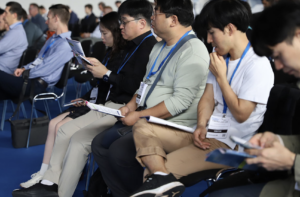
In particular, Dr Jianxia Guo, chief scientist and deputy general engineer at the Meteorological Observation Center at the China Meteorological Administration China, gave a presentation called “Experimental study on measurement uncertainty of air temperature observation”. In this talk, Guo discussed how, due to the uncertainty of temperature measurement caused by the reflection of solar radiation from the ground, the net infrared radiation of the shield and the wind speed inside the shield, field experiments are designed to measure the influencing factors, and the uncertainty of the air temperature is evaluated.
Additionally, Dr Michael Earle, manager of change management and innovation at the Meteorological Service of Canada, presented the key outcomes from the WMO initiative to advance the environmental sustainability of observing systems and methods. Recognizing the environmental impacts of operational weather monitoring programs, Earle spoke about how the WMO launched the initiative to promote and advance the environmental sustainability of observing systems and methods in late 2021. Under the guidance of INFCOM and with the Meteorological Service of Canada in a leadership role, this initiative has progressed through engagement and collaboration with the WMO, national meteorological and hydrological services and the vendor community. This presentation provided a summary of key milestones and takeaways from the environmental sustainability initiative since its inception, providing a transition point as it enters a new phase of leadership under INFCOM’s Study Group on Environmental Sustainability (SG-EnvS).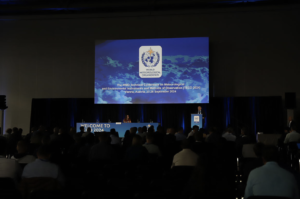
Visitor quotes
Jane Warne, chair of the Standing Committee on Measurements, Instrumentation and Traceability (SC-MINT) and principal meteorologist at the Australian Bureau of Meteorology, said, “The event has been very interesting. There are lots of good presentations and posters. There’s a lot of learning going on – even for someone like me, who’s been in this space for a long time. We have many problems we like to move ahead to improve services for normal people, especially in weather forecasting. The solution to these issues is built on good quality data that comes out of proper measurement equipment. The community here, the people giving their talks and those sharing their knowledge on the expo floor is how we get to those important solutions. Bringing people together like this definitely gives me optimism. Once you start bringing people together face-to-face, they build better relationships than online interactions. The human contact gives someone to go and reach out to when they’ve got a problem or want to collaborate. For me, this is a very important activity. Connecting the industry and the user gets better outcomes all around. Meteorological manufacturers benefit by gaining a better understanding of what we need and we benefit from understanding what they can provide. We then start collaborating and get much better results for the man on the street. Hopefully, he doesn’t get rained on as often.”
Jean Bienvenu Dinga, director of Congo’s National Hydrological Service and Congo’s WMO representative, said, “This show is the opportunity for me to show what we are doing and the technology to use. It’s also great to source some products that can collect and model the right data to help the community in my country and model to the world. I’m happy to be here with the WMO. It’s so important to come to this show and find solutions with the operational ability to adapt to the impacts of climate change.”
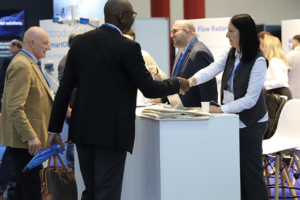
Andrius Laurynaitis, head of measurement quality and technical department at the Lithuanian Hydrometeorological Service, said, “At the moment, we are planning to launch a few tenders out for C band radars as we plan to buy new ones, so that’s a key reason we’ve come here. It’s so convenient to have both the TECO conference and the expo together so you can do it all in one week. You don’t have to organize separate meetings to meet partners from all over the world right here. It’s also been great to discover more about other meteorological topics, for example, I’ve heard some very interesting things about water discharge measurements at the expo. I’ve then had the chance to discuss the technology with experts and ask them questions directly. It’s been a fruitful show. This is actually my seventh time coming to the show. There’s always new and innovative things to see here.”
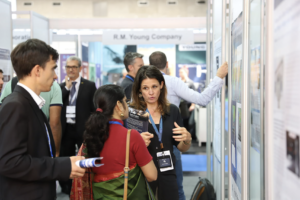
Enrico Chinchella, a research fellow at the University of Genova, commented, “The TECO conference was very interesting. I saw different approaches from various researchers on methodological measurement. As a researcher myself, it was great to see so many people interested in all these topics. I’m here for rainfall measurement, [specifically to find out more about the work being done to address] the errors in rainfall data. It was interesting to see other teams working on similar topics. It’s still a problem we need to solve as soon as possible.”
Arpita Rastogi, scientist at the India Meteorological Department, said, “This event is great for expert exposure, interacting with all the vendors and seeing the different kinds of instruments, from solutions as small as radiosondes all the way up to radars. It’s been lovely talking to one and all. It’s very beneficial for us it to have an event like this where you have the expo and the conference together because you get to know the industry and see all the improvements and new technologies coming up.”
Exhibitor quotes
Scott Cornelsen, principal engineer – electrical design, at Campbell Scientific, said, “This show is a really interesting opportunity. It’s a meeting between the industry and the science of meteorology. It’s the chance for everyone to discuss and discover what people need to do the jobs they’re trying to do, and also what the industry can do to provide for that requirement. Amazing things happen when those two groups meet each other in the middle. That’s because the capabilities for what’s required for science are still being developed. It’s neat to see those conversations happen and watch the technology come together. This year, I’ve seen many familiar names and some new companies and ideas. It’s interesting to see what’s new and to see that many of the tried-and-true names are still in the business.”
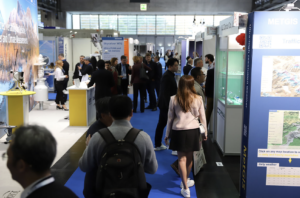
Alana Dachtler, vice president of sales and marketing at InterMet (International Met Systems), commented, “InterMet has been an exhibitor at the Met Tech Expo since the forum was established. This has always been a great venue to connect with customers, and we’re excited to introduce our latest technology for drone-based ABL weather observations to the weather community. We are eager to meet with the technology-savvy customers who are ready to adopt a new platform for weather observation that will significantly enhance our understanding of the atmosphere.”
“We are very happy to participate in the Meteorological Technology World Expo and be able to share our new technologies and new concepts with the international community of meteorology and climate,” said Jean-Sébastien Cases, VP of sales and marketing at Meteo France International (MFI). “We are particularly keen to meet decision makers from national hydrometeorological services from around the world to show them our W4ALL concept, which we believe is the only all-in-one solution currently on the market to respond to the Early Warnings for All call. The deadline set by the United Nations is for the end of 2027 so we need to get things moving! We are ready to discuss with all visitors the technical solutions and global approach we propose to efficiently implement relevant early warning and early action value chains.”
Don’t miss out on the meteorological show of the year – the event returns to Vienna, Austria on October 14, 15 & 16, 2025. Visit the website for all the latest information.


